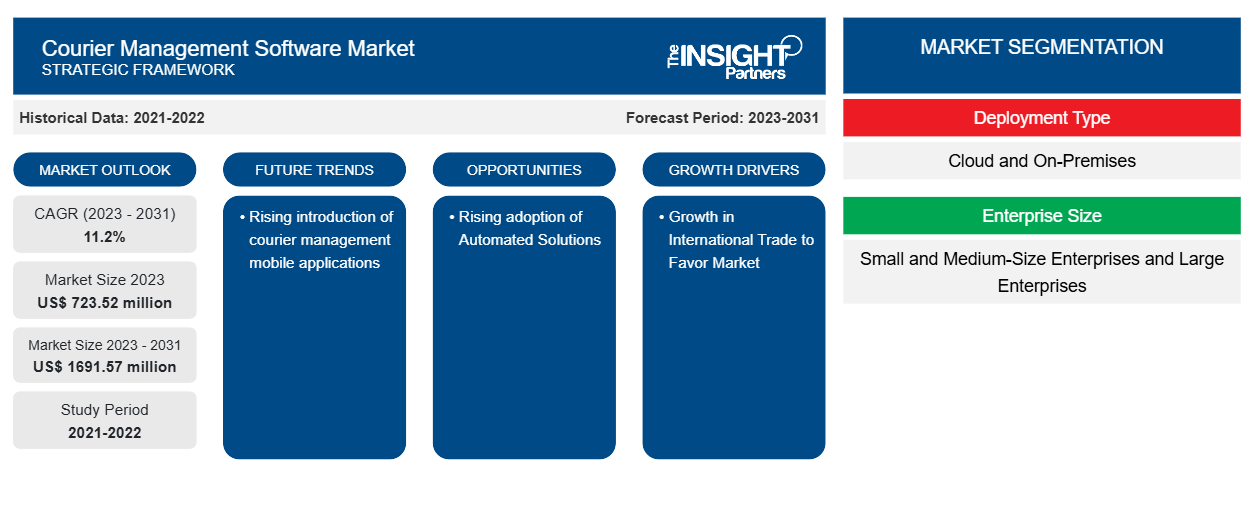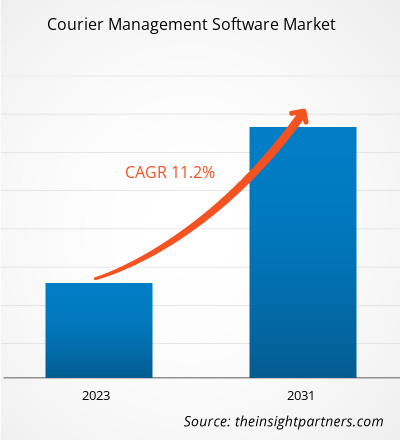The global courier management software market size is expected to grow from US$ 723.52 million in 2023 to US$ 1691.57 million by 2031; it is anticipated to expand at a CAGR of 11.2% from 2023 to 2031. The rising introduction of courier management mobile applications is likely to remain a key courier management software market trends.
Courier Management Software Market Analysis
The growth in international trade is expected to have a positive impact on the courier management software market. As international trade increases, the demand for efficient logistics and delivery management solutions also grows.
Courier Management Software Market Overview
Courier management software is a comprehensive software solution designed to assist businesses in efficiently managing and tracking shipment orders for packages or products. This software offers a range of features and functionalities that streamline various aspects of the delivery process, ultimately improving customer satisfaction and optimizing operational efficiency. Courier software provides real-time GPS monitoring of shipments, allowing businesses to track the status and location of packages throughout the delivery process.
Customize This Report To Suit Your Requirement
You will get customization on any report - free of charge - including parts of this report, or country-level analysis, Excel Data pack, as well as avail great offers and discounts for start-ups & universities
Courier Management Software Market: Strategic Insights

-
Get Top Key Market Trends of this report.This FREE sample will include data analysis, ranging from market trends to estimates and forecasts.
Courier Management Software Market Drivers and Opportunities
Growth in International Trade to Favor Market
The growth in international trade has a positive impact on the courier management software market. As international trade increases, the demand for efficient logistics and delivery management solutions also grows. International trade involves the exchange of goods and services between countries. It requires effective coordination and management of logistics, including transportation, warehousing, and delivery. Courier management software plays a crucial role in streamlining these processes, improving efficiency, and ensuring timely delivery of goods.
Rising adoption of Automated Solutions
The growing investments in courier software by e-commerce firms and the rising popularity of software as a service (SaaS) are propelling the courier software market forward. These software systems play a vital role in streamlining business operations, enhancing customer communication, providing real-time visibility of shipments, optimizing routing options, and more. By integrating courier software into their existing systems, companies can automate various processes such as customer order entry, accounts receivable, real-time delivery tracking, and account management. Furthermore, to stay competitive, courier software vendors are implementing technologically advanced and customer-centric pricing strategies.
Courier Management Software Market Report Segmentation Analysis
Key segments that contributed to the derivation of the courier management software market analysis are deployment type and enterprise size.
- Based on deployment type, the market is bifurcated into Cloud and On-Premises. The cloud segment held a larger market share in 2023.
- Based on enterprise size, the market is bifurcated into small and medium-sized enterprises and large enterprises. The large enterprises segment held a larger market share in 2023.
Courier Management Software Market Share Analysis by Geography
The geographic scope of the courier management software market report is mainly divided into five regions: North America, Asia Pacific, Europe, Middle East & Africa, and South America/South & Central America. North America dominated the Courier Management Software market in 2023. Due to the growing popularity of courier software in enhancing supply chain management, there is a rising demand for a reliable platform that can handle end-to-end shipping requirements for online shopping of both essential and non-essential products. The commercial sector in the region is witnessing significant technological advancements, which are fuelling the growth of the courier software market. Furthermore, the swift adoption of technology in the industrial sector across North American countries is also contributing to the expansion of the courier software market in the region.
Courier Management Software Market Regional InsightsThe regional trends and factors influencing the Courier Management Software Market throughout the forecast period have been thoroughly explained by the analysts at The Insight Partners. This section also discusses Courier Management Software Market segments and geography across North America, Europe, Asia Pacific, Middle East and Africa, and South and Central America.
Courier Management Software Market Report Scope
| Report Attribute | Details |
|---|---|
| Market size in 2023 | US$ 723.52 million |
| Market Size by 2031 | US$ 1691.57 million |
| Global CAGR (2023 - 2031) | 11.2% |
| Historical Data | 2021-2022 |
| Forecast period | 2023-2031 |
| Segments Covered |
By Deployment Type
|
| Regions and Countries Covered |
North America
|
| Market leaders and key company profiles |
|
Courier Management Software Market Players Density: Understanding Its Impact on Business Dynamics
The Courier Management Software Market is growing rapidly, driven by increasing end-user demand due to factors such as evolving consumer preferences, technological advancements, and greater awareness of the product's benefits. As demand rises, businesses are expanding their offerings, innovating to meet consumer needs, and capitalizing on emerging trends, which further fuels market growth.

- Get the Courier Management Software Market top key players overview
Courier Management Software Market News and Recent Developments
The courier management software market is evaluated by gathering qualitative and quantitative data post primary and secondary research, which includes important corporate publications, association data, and databases. The following is a list of developments in the market:
- In September 2023, Delhivery, a logistics services provider, has recently launched a location intelligence solution called 'LocateOne' to help businesses improve address data, rooftop accuracy, and reduce fraud. This new feature is part of Delhivery's software offerings on the OS1 platform. OS1 is a software platform that provides full solutions for businesses to efficiently run their logistics and supply chain operations.
(Source: Delhivery, Press Release, 2023)
Courier Management Software Market Report Coverage and Deliverables
The "Courier Management Software Market Size and Forecast (2021–2031)" report provides a detailed analysis of the market covering below areas:
- Market size and forecast at global, regional, and country levels for all the key market segments covered under the scope
- Market dynamics such as drivers, restraints, and key opportunities
- Key future trends
- Detailed PEST/Porter's Five Forces and SWOT analysis
- Global and regional market analysis covering key market trends, major players, regulations, and recent market developments
- Industry landscape and competition analysis covering market concentration, heat map analysis, prominent players, and recent developments
- Detailed company profiles
Frequently Asked Questions
What is the estimated market size for the global courier management software market in 2023?
What are the driving factors impacting the global courier management software market?
What are the future trends of the global courier management software market?
Which are the key players holding the major market share of the global courier management software market?
What will be the market size of the global courier management software market by 2031?
- Historical Analysis (2 Years), Base Year, Forecast (7 Years) with CAGR
- PEST and SWOT Analysis
- Market Size Value / Volume - Global, Regional, Country
- Industry and Competitive Landscape
- Excel Dataset
Recent Reports
Related Reports
Testimonials
Reason to Buy
- Informed Decision-Making
- Understanding Market Dynamics
- Competitive Analysis
- Identifying Emerging Markets
- Customer Insights
- Market Forecasts
- Risk Mitigation
- Boosting Operational Efficiency
- Strategic Planning
- Investment Justification
- Tracking Industry Innovations
- Aligning with Regulatory Trends





















 Get Free Sample For
Get Free Sample For